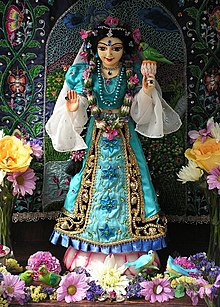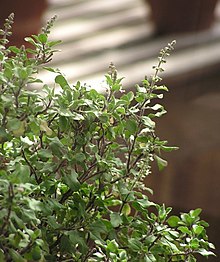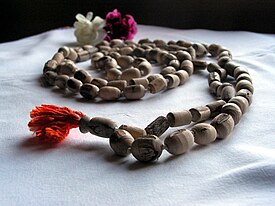Tulsi in Hinduism
| Tulsi | |
|---|---|
Personification of Tulsi plant | |
 An idol of the goddess | |
| Other names | Vrinda |
| Devanagari | तुलसी |
| Sanskrit transliteration | Tulasi |
| Affiliation | Devi,
|
| Abode | The Tulsi plant, Vaikuntha |
| Mantra | Om tripuraaya vidmahe tulsi pathraya dheemahi tanno tulsi prachodayat |
| Symbol | The Tulsi plant |
| Festivals | Tulsi Vivah |
| Parents | |
| Consort |
|

| Part of a series on |
| Vaishnavism |
|---|
 |
|
|
Tulsi, Tulasi or Vrinda (Holy Basil) is a sacred plant in Hindu belief. Hindus regard it as an earthly manifestation of the goddess Tulsi; she is regarded as the avatar of Lakshmi, and thus the consort of the god Vishnu. In other legends, she is called Vrinda and distinct from Lakshmi. In the story, she married Jalandhara. The offering of its leaves is recommended in ritualistic worship of Vishnu and his avatars like Krishna and Vithoba.
Many Hindus have tulsi plants growing in front of or near their home, often in special pots or a special masonry structure known as Tulsi Vrindavan as this is related to their culture. Traditionally, Tulsi is planted in the center of the central courtyard of Hindu houses.[2] The plant is cultivated for religious purposes, and for its essential oil.
Names[]
In Hindu vedas, Tulsi ("matchless") is known as Vaishnavi ("belonging to Vishnu"), Vishnu Vallabha ("beloved of Vishnu"),[3] Haripriya ("beloved of Vishnu"), Vishnu Tulsi. The Tulsi with green leaves is called Shri-Tulsi ("fortunate Tulsi"); Shri is also a synonym for Lakshmi, Vishnu's spouse. This variety is also known as Rama-Tulsi ("bright Tulsi"); Rama is also one of the principal avatars of Vishnu. The Tulsi with dark green or purple leaves and purple stem is called Shyama-Tulsi ("dark Tulsi") or Krishna-Tulsi ("dark Tulsi"); Krishna is also a prominent avatar of Vishnu. This variety is considered especially sacred to Krishna, as its purple color is similar to Krishna's dark complexion.[3][4]
One argument mooted is that goddess Laksmi is also identical with Tulsi and hence it is also known as Lakshmi Priya; Tulsi is also identified with the wives of other incarnations of Vishnu, such as Rama and Krishna.
Legends[]

The Devi Bhagavata Purana regards Tulsi as an manifestation of Lakshmi, the goddess of wealth and principal consort of Vishnu. Once upon a time, King Vrishadhvaja—a devotee of the god Shiva—banned worship of all other deities except for that of his patron god. An agitated sun god Surya cursed him that he would be abandoned by Lakshmi. Upset, Shiva pursued Surya, who fled, finally seeking shelter with Vishnu. Vishnu said to the deities that years had passed on earth. Vrishadhvaja and also his heir-son were dead and his grandchildren—Dharmadhvaja and Kushadhvaja—were now worshiping Lakshmi to gain her favor. Lakshmi rewarded their efforts by being born as their daughters Tulsi (literally "matchless") to Dharmadhvaja and Vedavati to Kushadhvaja, respectively. In time, Tulsi gave up all her royal comfort and went to Badrinath to perform penance to gain Vishnu as her husband. The god Brahma was pleased with her penance but told her that she would have to marry the daitya Shankhachuda before she could marry Vishnu.
Curse of Tulsi & Lord Vishnu[]
Shankhchuda was Sudama reborn. Though he was a devotee of Shri Krishna, he detested Shri Radha. He considered Prema as Vilas. Once on his visit to Golok, Shri Krishna asked him to guard the gate of His palace and not allow anyone to enter. Following the order, he stopped Shri Radha from entering Shri Krishna's palace as He was resting. They got into a heated argument. In a fit of anger, he cursed Shri Radha that she would forget all about Shri Krishna and would abandon Golok and live on Lok (Prithvi) for a hundred years. He was made to realise that Radha-Krishna's prema is the foundation of the universe. He too was cursed to be born on Prithvi as Shankhchuda.
This mighty daitya underwent terrific tapa and penance and pleased Brahma. Brahma blessed him with a boon of invincibility. Shankhachuda pleased Brahma with his penance, was granted the Vishnu-Kavacha (armour of Vishnu) and he blessed shankhachuda that as long as Vishnu-Kavacha was on his body, no one could slay him. Shankhachuda and Tulsi were soon married. He practiced the laws of dharma religiously but was also prone to commit mistakes and sins for the sake of community. Therefore, after victory over the three worlds, he drove out gods from various celestial kingdoms. To rescue the universe, Shiva challenged Shankhachuda to war. Vishnu appeared in his true form and urged Tulsi to abandon her earthly body and return to his celestial abode. In her anger and grief, she cursed Vishnu to be turned into stone. Vishnu turned into a stone and reside on riverbank Gandaki River. People and devotees will call it a chunk of Shaligrama. Tulsi's mortal remains decayed and became the Gandaki River, while her hair transformed into the sacred Tulsi plant.[5][6]
Vrinda and Jalandhara[]
A variant of the legend replaces the name Tulsi with Vrinda (a synonym of the Tulsi plant) and in this legend, Tulsi is distinct from Lakshmi. She was daughter of Kalanemi, an asura. Vrinda was very pious and a great devotee of god Vishnu. Jalandhara, a demon born from lord Shiva's rage, married her. After Jalandhara took control of the three realms, he had a conflict with lord Shiva. To protect her husband from death, Vrinda performed a penance which made him immortal.
The later part of the story concentrates on the tale of Vishnu destroying Vrinda's chastity to lead to the death of Jalandhara by Shiva. Different texts suggest different methods used by Vishnu. Some say that Vishnu, disguised as Jalandhara, performed a ritual belonging to married couples, others say that Vishnu broke Vrinda's fast or slept with her.[7] The legend ends with Vrinda cursing Vishnu to become a stone, turning him the Shaligram stone (which are found only in the Kali Gandaki River of Nepal) and Vishnu transforming Vrinda into the Tulsi plant. In a variant, Vrinda immolated herself in her husband's funeral pyre (see sati) but Vishnu ensured that she got incarnated in the form of tulsi plant on the earth. In both versions, she gain the status of a goddess named Tulsi, while her earthly form is the Tulsi plant.[8][9]
Other Legends[]
A Vaishnava legend relates Tulsi to the Samudra Manthana, the churning of the cosmic ocean by the gods and asuras (demons). At the end of the churning, Dhanvantari rose from the ocean with Amrita (the elixir of immortality). Vishnu procured it for the gods, when the demons tried to steal it. Vishnu shed happy tears, the first of which fell in Amrita and formed Tulsi.[6]
Worship[]


While tree worship is not uncommon in Hinduism, the Tulsi plant is regarded as the holiest of all plants.[10] The Tulsi plant is regarded as a threshold point between heaven and earth. A traditional prayer narrates that the creator-god Brahma resides in its branches, all Hindu pilgrimage centres reside in its roots, the Ganges flows within its roots, all deities are in its stem and its leaves, and that the most sacred Hindu texts, the Vedas are found in the upper part of the holy basil's branches.[11][8] The Tulsi herb is a centre of household religious devotion particularly among women and is referred to as the "women's deity" and "a symbol of wifehood and motherhood", it is also called "the central sectarian symbol of Hinduism" and Vaishnavites consider it as "the manifestation of god in the plant kingdom".[12][6]
The Tulsi plant is grown in or near almost every Hindu house, especially by Brahmins and other Hindu castes of the Vaishnavite sect. A house with a Tulsi plant is sometimes considered a place of pilgrimage.[13] The sacred groves where these herbs are grown are also known as Vrindavan (grove of Tulsi), a miniaturised Vrindavan is a raised cuboid stone or brick structure often in middle of the house's courtyard or in front of the house.[14]
A person who waters and cares for the Tulsi daily is believed to gain spiritual merit and the divine grace of Vishnu, even if he does not worship it. Traditionally, the daily worship and care of the plant is the responsibility of the women of the household. Though daily worship is prescribed, Tuesdays and Fridays are considered especially sacred for Tulsi worship. Rituals involve watering the plant, cleaning the area near the plant with water and cow dung and making offerings of food, flowers, incense, Ganges water, etc. Rangoli (decorative designs) of deities and saints are drawn near its foot. Devotees pray to Tulsi and circumambulate the plant while chanting mantras. The Tulsi plant is often worshipped twice in a day: in the morning and in the evening, when a lamp or candle is lit near the plant.[15]
In the 19th century, some families in Bengal regarded the plant as their spiritual guide or clan deity. In a British Indian census, North-Western Provinces recorded themselves as Tulsi worshippers and not belonging to Hindus, Muslims or Sikhs.[10][8]
In Orissa, on the first day of the Hindu month Vaishakha (April–May), a small vessel with hole at the bottom is filled with water and suspended over the Tulsi plant with a steady stream of water, for the entire month. In this period, when a hot summer reigns, one who offers cool water to Tulsi or an umbrella to shelter it from the intense heat is believed to be cleansed of all sin. The stream of water also conveys wishes for a good monsoon.[16]
Festivals:
Tulsi Vivah[]
A ceremony known as Tulsi Vivah is performed by the Hindus between Prabodhini Ekadashi (eleventh lunar day of the waxing moon of Kartika) to Kartik Poornima (full moon in Kartika), usually on the eleventh or the twelfth lunar day. It is the ceremonial wedding of the Tulsi plant to Vishnu, in the form of his image, Shaligram or a Krishna or Rama image. Both the bride and the groom are ritually worshipped and then married as per traditional Hindu wedding rituals. It marks the end of the four-month Chaturmas period, which corresponds to the monsoon and is considered inauspicious for weddings and other rituals, so the day inaugurates the annual marriage season in India.[17][18][19]
In worship of other deities[]

Tulsi is especially sacred in the worship of Vishnu and his forms Krishna and Vithoba and other related Vaishnava deities.[12][6] Garlands made of 10000 tulsi leaves, water mixed with tulsi, food items sprinkled with Tulsi are offered in veneration to Vishnu or Krishna.
Vaishnavas traditionally use japa malas (a string of Hindu prayer beads) made from Tulsi stems or roots called Tulsi malas, which are an important symbol of the initiation. Tulsi malas are considered to be auspicious for the wearer, and believed to connect him with Vishnu or Krishna and confer the protection of the deity. They are worn as a necklace or garland or held in the hand and used as a rosary. Tulsi's great connection with Vaishnavas is communicated with the fact that Vaishnavas are known as "those who bear the tulsi round the neck".[20] Some pilgrims carry tulsi plants in their hands throughout their pilgrimage to Dwarka, the legendary capital of Krishna and one of the seven most sacred Hindu cities.[3]
There are conflicting accounts about Tulsi leaves being used in the worship of the god Shiva. While Bael leaves are often offered to Shiva, some authors note that Tulsi may also be offered to him. Tulsi worship is sometimes regarded the worship of Shiva, conveying the deity's omnipresence. Shiva's aniconic symbol – the linga – is sometimes prescribed to have made from the black soil from the roots of the Tulsi plant. However, Tulsi is taboo in worship of the Devi – the Hindu Divine Mother as the pungent aroma of the Tulsi plant angers her.[13] It is also important for the worship of Hanuman.[4] In Orissa, the Tulsi plant represents all local deities and rituals to propitiate them are offered in front of the plant. The Nayars of Malabar offer Tulsi plants to pacify evil spirits.[21]
Importance in Hinduism[]
In Srimad Bhagavatam, the significance of the Tulsi over other plants is described as:
Although flowering plants like the mandāra, kunda, kurabaka, utpala, campaka, arṇa, punnāga, nāgakeśara, bakula, lily and pārijāta are full of transcendental fragrance, they are still conscious of the austerities performed by tulasī, for tulasī is given special preference by the Lord, who garlands Himself with tulasī leaves
— Srimad Bhagavatam, Canto 4, Chapter 15, Verse 19[22]
Every part of the Tulsi plant is revered and considered sacred. Even the soil around the plant is holy. The Padma Purana declares a person who is cremated with Tulsi twigs in his funeral pyre gains moksha and a place in Vishnu's abode Vaikuntha. If a Tulsi stick is used to burn a lamp for Vishnu, it is like offering the gods lakhs of lamps. If one makes a paste of dried Tulsi wood (from a plant that died naturally) and smears it over his body and worships Vishnu, it is worth several ordinary pujas and lakhs of Godan (donation of cows).[23] Water mixed with the Tulsi leaves is given to the dying to raise their departing souls to heaven.[6]
Just as Tulsi respect is rewarding, her contempt attracts the wrath of Vishnu. Precautions are taken to avoid this. It is taboo to urinate, excrete or throw waste water near the plant. Uprooting and cutting branches of the plant is prohibited.[24] When the plant withers, the dry plant is immersed in a water body with due religious rites as is the custom for broken divine images, which are unworthy for worship.[6] Though Tulsi leaves are necessary for Hindu worship, there are strict rules for it. A prayer of forgiveness may also be offered to Tulsi before the act.[24]
The word Tulsi is used in many place names and family names.[10]
References[]
- ^ https://archive.org/stream/puranicencyclopa00maniuoft#page/778/mode/1up
- ^ Simoons 1998, pp. 17–18.
- ^ Jump up to: a b c Simoons 1998, p. 14.
- ^ Jump up to: a b Chatterjee, Gautam (2001). Sacred Hindu Symbols. Abhinav Publications. p. 93. ISBN 978-81-7017-397-7.
- ^ Mani pp. 797–8
- ^ Jump up to: a b c d e f Deshpande 2005, p. 203.
- ^ Littleton & Corporation 2005, pp. 1124–36.
- ^ Jump up to: a b c Littleton & Corporation 2005, pp. 1125–6.
- ^ Simoons 1998, p. 11.
- ^ Jump up to: a b c Simoons 1998, p. 8.
- ^ Simoons 1998, pp. 7, 9.
- ^ Jump up to: a b Simoons 1998, pp. 11–18.
- ^ Jump up to: a b Simoons 1998, p. 17.
- ^ Simoons 1998, pp. 18–20.
- ^ Simoons 1998, p. 20.
- ^ Simoons 1998, pp. 20–2.
- ^ Flood, Gavin D. (2001). The Blackwell companion to Hinduism. Wiley-Blackwell. p. 331. ISBN 978-0-631-21535-6.
- ^ Simoons 1998, p. 22.
- ^ "Tulsi Vivah". Sanatan Sanstha. 18 October 2000. Retrieved 30 June 2021.
- ^ Simoons 1998, pp. 14–6.
- ^ Simoons 1998, p. 16.
- ^ https://vedabase.io/en/ https://vedabase.io/en/library/sb/3/15/19/. Retrieved 24 February 2020. Missing or empty
|title=(help); External link in|website=(help) - ^ Mani p. 798
- ^ Jump up to: a b Simoons 1998, pp. 22–3.
Bibliography[]
| Wikimedia Commons has media related to Tulsi in Hinduism. |
- Littleton, C. Scott; Marshal Cavendish Corporation (2005). Gods, Goddesses, And Mythology, Volume 11. Marshall Cavendish. pp. 1124–26. ISBN 9780761475590.
- Simoons, Frederick J. (1998). Plants of life, plants of death. Univ of Wisconsin Press. pp. 7–40. ISBN 978-0-299-15904-7.
- Mani, Vettam (1975). Puranic Encyclopaedia: a Comprehensive Dictionary with Special Reference to the Epic and Puranic Literature. Motilal Banarsidass Publishers. p. 797. ISBN 978-0-8426-0822-0.
- Deshpande, Aruna (2005). India: A Divine Destination. Crest Publishing House. p. 203. ISBN 81-242-0556-6.
- Dalal, Roshen (1998). Hinduism: An Alphabetical Guide. Penguin Books India. p. 424. ISBN 9780143414216.
- Ocimum
- Plants used in Ayurveda
- Sacred trees in Hinduism
- Hindu goddesses
- Trees in mythology